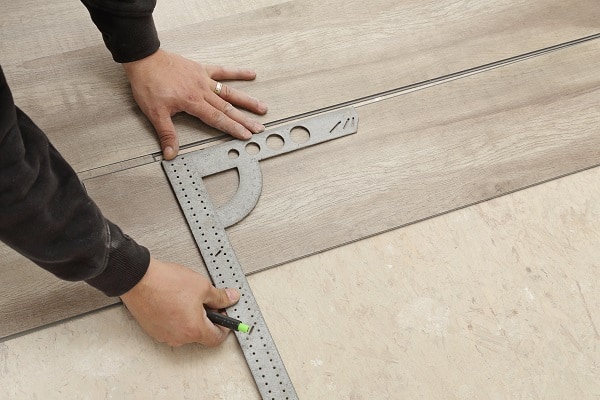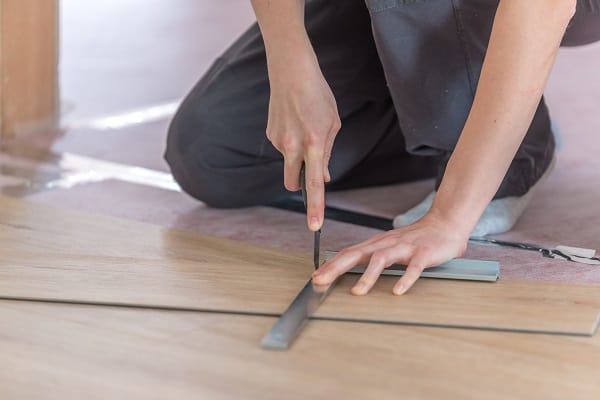It’s time to make some upgrades to your home. You’ve decided to install vinyl plank flooring, since it seems so quick and easy. But you’re wondering, “what’s the best way to cut vinyl plank flooring?”
Once you know where and how to cut vinyl plank flooring, you will save yourself a lot of trouble. This article will provide you with the techniques and tools to ensure you make the right cut.
Read: Our comparisons and reviews of the best selection of vinyl flooring.
Measure Twice, Cut Once

Good preparation is the key to success when you are installing vinyl plank flooring. If you rush the installation or start ill-prepared, there are more chances for mistakes.
First, you should let the vinyl planks rest in the room for a couple of days to acclimatize. When you start cutting and laying the planks, it is advisable to use planks randomly get a more consistent look.
Before the installation, measure the area carefully. Start from the longest wall and work your way from there. At this point, a laser distance measure would come in handy. The Stanley Pocket Laser Distance Measurer has a 1/4-inch accuracy at 30 feet and a 2-year warranty.
Also, find the center of each wall and draw lines between them. It is useful to use a chalk line tool. According to customer reviews, the Stanley 47-443 3 Piece Chalk Box Set is one of the best chalk line tools available. It includes an additional 4 oz. bottle of Blue Stanley Chalk, and a tiny level. This chalk line tool should last you a long time because it comes in a high-impact ABS case.
Your vinyl plank flooring may need an expansion gap. This is the last measurement parameter before you make the first cut. The expansion gap should be 5/16 in. from each wall. Use your chalk line tool to snap a straight line between the walls.
Making the First Cut

Now that all of your measurements are down and your floor is clean, except for the chalk lines of course, it’s time to cut.
We will take you through the process step by step. Useful tips on preferred methods and tools should help you understand the best way to cut vinyl plank flooring.
Determine How Wide the Last Row Is
This should be the first cut you make. Determine the width of the last row of vinyl plank flooring. If the width is less than ⅓ of a plank, cut roughly ⅓ of the plank in the first row. This will ensure an even start and finish of the rows and reduce the number of rejects.
For this step you will need a T-square and a utility knife or a handsaw. Whether you use a handsaw or a utility knife may depend of the type of vinyl plank flooring you purchased. Some brands may be thicker than others.
To avoid fatigue and chipping, it is advisable to use an electric handsaw. The Black & Decker 3.4 Amp Navigator Combo Set is an excellent option. It has a 4600 SPM motor and can cut wood, metal and plastic. It comes with 3 additional blades: a curve-cutting blade, a metal-cutting blade and a general-purpose blade. These may allow you to cut grooves under doorjambs and snugly place the planks underneath.
Getting the First Row Down
You need to remove the tongue from the plank. The easiest way to do this is by using a utility knife. The Milwaukee Fastback Flip Open Utility Knife is one of the best sellers. With almost 500 positive customer reviews and the included wire stripper, it is definitely worth checking out.
Once you’ve cut the tongues, you should lay the first row with the cut side facing the wall. Also, carefully place the vinyl planks to keep an even expansion gap between them and the wall.
Putting the Planks in Place
Your first plank is down. Take the second one, put it at a slight angle against the first, and fold gently until they click into place. You should note, the final piece should be bigger than 6 inches. If not, you can take a bit from the first plank.
Finishing Off the Rows
To fit the last piece you can score it using a utility knife and break off the excess piece. Use a T-square to ensure an even cut. It is useful to use the extra piece to begin new rows, as long as they are 6 or more inches long. This ensures a uniform layout and reduces the number of excess pieces in the end.
The Second Row and Beyond

Remember, you have to stagger the joints at 6 inches, at least. Measuring the first piece is very important. You can use the Stanley Powerlock 25-foot by 1-inch Measuring Tape. It is very durable and comes with a high-impact ABS case, heat-treated spring and Mylar-coated blade, which should ensure longevity.
Connecting the Planks
The tongue of the first piece goes into the groove of the previous one and gently rotates until they click together. Next, connect the short end of the vinyl plank, then the long end. After they lock, you should feel it in your hands. Click and lock your way along the room, minding the 6-inch joint stagger and the expansion gap.
Doorjambs and the Finish
Get the vinyl planks under the doorjambs, as this provides an even fit of your flooring. If you cannot get under the doorjambs, you can use an electric handsaw to cut a small groove. Use a pull bar or a tapping block if the fit is hard to reach.
You can cut and nail the trim to the wall. The Stanley Saw Storage Mitre Box with 12-inch Backsaw can help you cut the angles required for the corners of the trim. It even comes with base holes which are useful if you want to fasten it to your workbench.
Lastly, you may want to add a shoe-molding. It is advisable to have the finish of the shoe-molding match the trim of the door, not the vinyl planks.
The Final Cut
We hope you now feel confident enough to start cutting and installing vinyl plank flooring. The best way to cut vinyl plank flooring is by using the proper tools and techniques.
